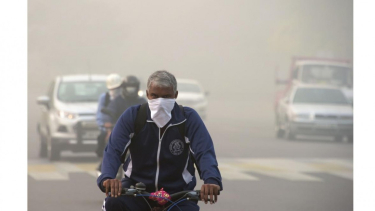There is No Completely Safe Place on Earth, Global Study Reveals
- vstory
VIVA – A team of scientists led by Professor Yuming Guo from Monash University School of Public Health and Preventive Medicine in Australia found that only 0.001 percent of the global population lives at PM2.5 levels, which are considered safe by World Health Organization (WHO) standards.
This research uses data from various sources such as air quality monitoring observations, satellite-based meteorological and air pollution detectors, and statistical and machine learning methods.
“In this study, we used an innovative machine learning approach to integrate multiple meteorological and geological information to estimate the global surface-level daily PM2.5 concentrations at a high spatial resolution of approximately 10km x 10 km for global grid cells in 2000-2019, focusing on the area above the safe limit by WHO,” Guo explained.
Kondisi udara di Jakarta yang penuh polusi. (Ilustrasi)
- VIVAnews/ M Ali Wafa
PM2.5 is an air pollutant composed of solid microparticles and liquid droplets that are about 10 nm to 2.5 m in size.
PM2.5 easily penetrates biological barriers and can therefore pose the greatest threat to the body, with new research suggesting that the size of the hazard may be larger than previously thought.
Researchers have identified PM2.5 change patterns that are period-specific for different macro-regions. Generally decreasing daily levels were marked in Europe and North America. Increased detections were recorded in southern Asia, Australia, New Zealand, Latin America, and the Caribbean.
High peaks in winter affect the East China Sea and North India while high peaks in summer for eastern regions in North America.
2019 was a peak year for Australia and New Zealand. Apart from the previous point, the lowest annual PM2.5 concentrations are associated with Australia and New Zealand as well as other regions in Oceania and the southern Americas. While the highest numbers were recorded in East Asia, South Asia, and northern Africa.
"We also recorded relatively high PM2.5 air pollution in August and September in South America and from June to September in sub-Saharan Africa," the professor said.
The new 2021 WHO guideline limit states that by 2019 only 0.18 percent of the global land area and 0.001 percent of the global population will have concentrations lower than the annual limit.
The researchers noted the importance of this study, as it will provide an in-depth understanding of the current state of outdoor air pollution and its impact on human health. With this information, policymakers and researchers can better assess the health impacts of air pollution and develop air pollution mitigation strategies.
The study titled 'Global estimates of daily ambient fine particle concentrations and uneven spatiotemporal distribution of population exposure: a machine learning modeling study' is published in The Lancet Planetary Health.
So it means that every part of the Earth has its risks and dangers, whether they be natural disasters, crime, terrorism, or other threats.





























